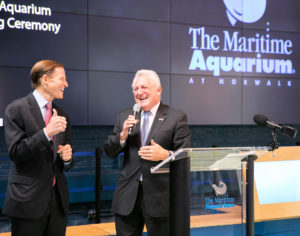Norwalk is “a really great city whose time has come,” according to Mayor Harry Rilling. “More people are starting to take notice of who we are and what we have to offer. We”™ve got it all.”
Recently elected to his fourth term, Rilling was referring to the city”™s resources, location, diversity and affordability. But having it all in this case includes some less pleasant matters as well: One of the major issues in the campaign against unaffiliated candidate Lisa Brinton was whether the city is developing too quickly; the political football that is the Walk Bridge replacement project continues to bounce; and, over several weeks, calls by the mayor and other civic leaders for Board of Education Chairman Mike Barbis to resign.

Bruce Kimmel eventually replaced the embattled Barbis on Nov. 19, but resigned after just a few days on the job citing political, personal and health reasons.
At issue was an email by Barbis that was leaked by an anonymous source three days before the Nov. 5 election, in which among other things he maintained that black politicians from South Norwalk, who opposed plans to raze and replace a school in District B, were “all SCUM ”¦. Blacks f*** Latinos.”
The mayor said Barbis”™ remarks do not reflect “who Norwalk is.”
The issue has been a particularly sore spot, Rilling said, because of his administration”™s work with the Board of Ed to improve the city”™s education system. The mayor has introduced a $189 million investment in Norwalk schools”™ infrastructure, and in the latest Connecticut Next Generation Accountability Report from the Connecticut Department of Education, Norwalk”™s accountability index score was 76.8%, compared to the state score of 74.9%.
Reaching Out to Small Businesses
Rilling said the finalist among three candidates to take over the directorship of Norwalk”™s Redevelopment Agency, from which Tim Sheehan resigned over the summer, should be announced within the next few weeks.
On Oct. 30, the city announced a new, $165,000 pilot initiative, the Small Business and Main Street Program, to help support local businesses and enhance quality of life across the city.
Part of the pilot includes a storefront improvement program with matching grants up to $10,000 to help fund seating, signage, lighting, window replacement, and more. The program will also include a streetscape improvement initiative in the Wall Street area, with funding allocated for benches, flowers, planters, and more. The city will work with local businesses and stakeholders on a comprehensive plan for the area.
Chief of Economic and Community Development Jessica Casey, who is overseeing the program, said its genesis came from conversations with various businesses in Norwalk”™s “urban core,” which includes Wall Street, West Avenue North, West Avenue South, and South Norwalk, and such groups as the Wall Street Neighborhood Association.
“We”™ve been listening to people and letting them know we”™re here to help,” Casey said. “We”™re looking to establish a two-way conversation to determine what our neighborhoods need to drive vitality and bring them to the next level.”
She noted that such a concentrated outreach program has never been done before in Norwalk, and that it is about “understanding the details. We may not be able to help absolutely everybody, but we want to include other viewpoints.”
Although the Small Business and Main Street Program has only been in place for a couple of weeks, Casey said some themes were already emerging.
“We”™ve heard that City Hall has been focusing on SoNo for a couple of decades, and that now it”™s time to put some of those resources into brightening the West side,” she said. Adding lighting and beautification projects “help instill ownership and pride in a neighborhood,” she added.
Concerns in the Merritt 7 and Glover Avenue areas are “more about transportation and mobility,” Casey continued. “We”™re looking at ways to link our urban core to Merritt 7.”
Ultimately the idea is to “be more strategic and holistic about what the city looks like,” she said, allowing that getting buy-in from residents will “take trust and time.”
The city is also undertaking a comprehensive review of its zoning regulations for the first time in some 30 years, Rilling noted. “Some of them have become antiquated, and we want to see what”™s consistent with our POCD (Plan of Conservation and Development),” the 10-year, state-mandated master plan recently approved unanimously by the Norwalk Common Council.
The POCD envisions that by 2029, Norwalk will have “become a national example of a small city that boasts a thriving and dynamic economy; varied housing choices for all income levels; many safe and convenient ways to get around the city, including walking and biking; connected, accessible and beautiful open spaces; a commitment to lifelong learning; and an active and resilient coastline.”
The mayor said he hoped the revisions to Norwalk”™s zoning regulations will be completed in the next 18-24 months.
All of this activity begs the question ”“ raised frequently by Brinton, Rilling”™s opponent in the November election ”“ of whether Norwalk is growing too rapidly. The mayor reiterated that initiatives like the Small Business and Main Street Program are meant to take such concerns into consideration.
But “We have to keep looking at the opportunities we have here,” he added. “We want to make sure we get it right. At the same time we need to continue to grow our Grand List,” which rose 16.6% last year to $14.3 billion. That growth has been due largely to new construction, Rilling said.
“There is a limited opportunity for single-family construction right now,” he said. “We need to address that while maintaining the unique character of our various neighborhoods.”
Malls and Bridges
The mayor also touted the recently opened SoNo Collection mall. “It”™s been a really positive addition to the city, traffic has not been as bad as people thought, although with the holidays there will be some struggles.”
He further noted that some 2,500 jobs will ultimately be created at the mall, “with a good percentage of them going to Norwalk residents ”“ everything from service jobs to management positions.”
As for the much-delayed Walk Bridge replacement — which will cost an estimated $511 million as part of an overall $1.2 billion package that includes several other transportation-related initiatives ”“ Rilling said the city is continuing to work closely with the state towards installing another moveable bridge rather than a fixed bridge, as some opponents have demanded.
In July, U.S. District Court Judge Stefan Underhill tossed a lawsuit filed by advocacy group Norwalk Harbor Keeper. That suit charged that the U.S. Department of Transportation”™s environmental study of the project was faulty, and maintained a fixed bridge would be less expensive and more environmentally friendly.
Rilling repeated his long-held belief that changing course on the Walk Bridge replacement would be a mistake. “Some say go with a fixed bridge, and I say, “Nay, nay!”™” he said. The new Walk Bridge includes a federal designation of a navigable waterway ”“ something he said a fixed bridge does not ”“ and is more conducive to waterfront development; the alternative would in effect turn the area into “a marsh.”
“The current Walk Bridge has been there for over 120 years, and I anticipate the next bridge will be there for at least that long as well,” he continued. “I don”™t want to limit the next two generations as to what they can do with that property.”






















